Kick Out the Jams
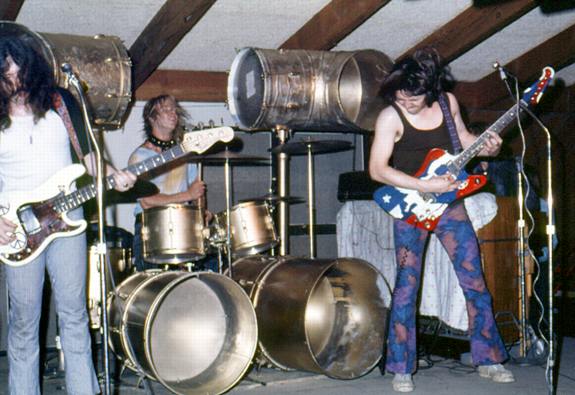
(Bob Seger at MT. Holly Ski Lodge near Pontiac. Real young.)
Sorry, gentle readers, I am traveling this morning and this is not done with even my usual casual interest to prof-reading.
The success of WABX inspired other Detroit stations WKNR-FM to adopt the passive-aggressive-progressive-rock approach to the new music. Our pal Lynn was the voice of morning radio in Detroit personality at 94.7 WCSX later, so I defer to her about how it all wound up with the lawyers.
Back then it was easy. The march of the Woodstock summer rolled and reeled across the Midwest. We had the lunatic festival at Goose Lake, featuring some of the same acts.
While not as widely known as Woodstock, the event was just as colorful and had better weather. The most popular images for me seem to have been the flag and the overt drug use. We slept outside in bedrolls, I think, though we may have had a tent. The music of Chicago- I think they had changed their name from CTA after the Transit Authority complained abut infringement- thundered into the clear night sky. “Twenty-Five or Six to Four” never sounded so good and so loud to people so wired.
Someone was shouting they were selling orgasms for fifty cents.
Cheap at twice the price, I thought.
It was cool to see the national and international acts- Rod Stewart and Jethro Tull were my favs from across the pond, and Leslie West’s Mountain was awesome. But goddamn, the Motor City proto-crazies were loud and proud and right there. Look at the lineup of SE Michigan acts:
Bob Seger, The Scott Richard Case (SRC), Brownsville Station, The Stooges and the bottom-of-the-litter, clean-out-the-hall MC5.
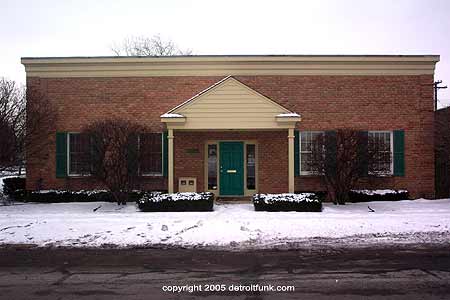
(Now an office building, this building used to be a VFW hall in the 1960’s known as The Hideout. Bands that performed at the Hideout included Bob Seger, Ted Nugent & The Amboy Dukes, MC5 and others.)
To most people in the world, Motown means slick bouncy well-packaged soul music. The other Motown sound meant the high-energy adrenaline overdrive of the MC-5, the Stooges and the Amboy Dukes. Bob Seger could rock with the best of them, and Mitch Ryder was a sold blue-collar straight-ahead Devil without a Blue Dress, sine he lifted the material direct from real R&B.
None of us cared, as I recall.
But before any of these bands broke out beyond regional prominence, they had to emerge from the thriving garage-band hotbed of the Detroit suburbs. The hottest venue in the days before the hippies was a place called The Hideout, which was a rented Harper Woods VFW hall that featured live music aimed at the teen audience. Local promoter Ed “Punch” Andrews’ later branched out with his own record label, Hideout Records.
The Hideout was the place to be, once you had a driver’s license. There you could see the bands that were going to make it out of the teen club and into something big: Bob Seger & the Last Herd, The Fugitives, SRC, Doug Brown & the Omens, the Heavy Metal Kids (featuring future Eagle Glenn Frey, Suzi Quatro & the Pleasure Seekers, and Ted Nugent & the Lourds.
The music was freaking awesome.
You might be surprised to note that Glenn Frey was a Detroiter, albeit from north of Eight Mile. He was a couple years older than our crowd- a true Boomer born in 1948 in Royal Oak. He went to arch-rival Royal Oak Dondero High School, and inspired by the wild 1964 Beatles concert at Olympia Stadium on Grand River, Glenn stopped taking piano and picked up the guitar.
As soon as he had mastered a few chords, Frey put together his first band. That group was The Subterraneans, after Jack Kerouac’s book, and they were a frequent headliner at The Hideout.
Soon after graduating in 1966, Glenn joined the Grabbingham folk-rock band called the Four Of Us, and then, like everyone, got out and moved to the Left Coast to win fame and fortune.
The ones who stayed were Wild Man and Reactionary Revolutionary Ted Nugent, the Nooge, and Smokin’ OP’ss Bob Seger. The latter may be the most famous Detroit Rocker who never left and never compromised where he came from.
Bob was born in Dearborn, to a father who had left Big Band music for the war production industry. When he was six, the Segers moved to Ann Arbor.
His old man was a shit-heel. He cut out for California to go back to music, and the family was destitute. He big brother had to leave school to work to hold things together, but Bob has able to afford a little AM transistor radio that he would listen to with the ear-plug late at night in the one-room apartment the three could afford.
Listening to CKLW, Bob heard the sweet soul of Wilson Pickett, Otis Redding, and James Brown.
The Hardest Working Man in Show Business was a huge influence on Seger. His first band was the The Decibels, a 1961 sophomore-year experiment. His next band was The Town Criers. The band worked several nights a week on the Detroit bar circuit and also enjoyed a regular gig backing strippers at clubs like The Primo Showbar, The Rock and Roll Farm, The Suds Factory and The Chances Are were favorites.
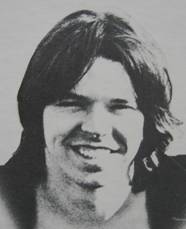
“East Side Story” was the first single with his group The Last Heard, and it reached #3 on the Detroit charts. The 1967 single “Heavy Music,” was the one that made me crazy along with a bunch of other kids, and had the potential to break him the hell out of Detroit, but his record company abruptly went out of business.
Take in a show these days- Bob is still on the road more than two hundred days a year. “Heavy Music” is still in his repertoire.
But the center of the Detroit Sex Drug and Rock and Roll scene in my time in late high school and college was the Grande Ballroom, which was run as a sort of greed-driven commune we were all expected to support, sort of like the government today.
What was coming, while I was there, was a showdown between the Grande Ballroom and the hard-edged Eastown Theater.
Gibbs was rooted in Flower Power at the Grande. He had the Fillmore Theatre vision, inspired by San Francisco, if you can imagine that on Detroit’s Grand Boulevard. He attempted to create a similar venue for the new acid music and a resource for local teenagers. Gibb worked closely with Detroit counterculture White Panther icon John Sinclair was a local music broker. John had lived around the corner from us in the Chi Phi house in Ann Arbor. He was immortalized in John Lennon’s tune “Ten for Two,” penned in response to John’s being busted for two marijuana joints and getting a sentence of ten years.
Sinclair helped bring in bands from San Francisco and harder-edged psychedelic rock Detroit bands gathering around the Plum Street community. The Grande featured acts like Led Zeppelin, Janis, Pink Floyd, The Dead, the original Beck, the Cream and The Who long before they looked like old me. The MC5, Thyme, and The Stooges were the house bands, who ensured you could get your nuts off regardless of who was headlining.
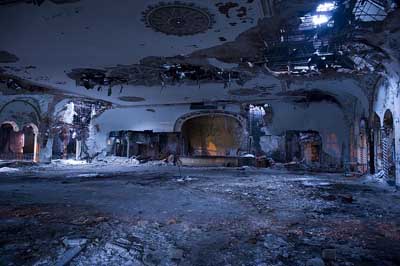
(Interior of the Grande Ballroom today.)
Russ Gibbs did not just feature loud. He made a conscious choice to book avant-garde jazz acts like John Coltrane, and Sun Ra.
Shoot, I understand why I tried to get it. I used to try to understand Miles Davis and never could.
We had our Detroit version of the posters that advertised the acts, which were patterned on Height-Ashbury in the golden days of psychedelic bliss. The art of Gary Grimshaw and Carl Lundgren were happily- no, savagely- anti-establishment.
For Detroiters of a certain age, the Eastown will be remembered for its noisy succession of the Grande Ballroom as the city’s go-to rock venue. While the Grande had captured the flower-power spirit of the ’60s, the Eastown embodied the harder-edged vibe of drug culture.
Think New York Dolls and Lou Reed and men in make-up and big hair. Who palyed there, before the 1930s decaying elegance and plush blue seats? The usual Detroit suspects and touring bands like the J. Geils Band, the James Gang and the Who.
The usual Detroit regional band took up the slack.
The Eastown quickly earned a notorious reputation, targeted by city officials and the news media for overcrowding, hard drug use and vandalism. The venue was shut down by the city in 1971, and “reopened for a brief spell two years later. A 1973 Free Press article described the scene during a concert by Joe Walsh, when the sweet, pungent smell of marijuana, popcorn and sweat mixed with the blaring rock music and shouts.”
That is the last time I saw the place. The music was fantastic in both places, but there was an edge, and entrepreneur Russ Gibbs is still doing whatever it is entrepreneurs to for a living.
Russ Gibb closed the Ballroom as a rock venue in 1972, and I missed the end, since no one was coming anymore. The building has rarely been used since, and I hate to lurch into Ruin Porn, but sort of have to.
As of 2010 it remained inactive and open to redevelopment, which in another Detroit is a call to “bring up the bulldozers.” The good news, from a bulldozer perspective, is that there are not enough of them. As the MC5 used to observe, “Kick out the jams, Mother Fuckers.”
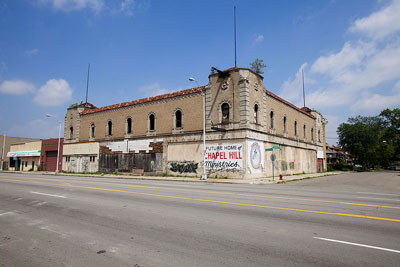
(Grande Ballroom this afternoon, Photo courtesy Albert Duce.)
Copyright 2011 Vic Socotra
www.vicsocotra.com
